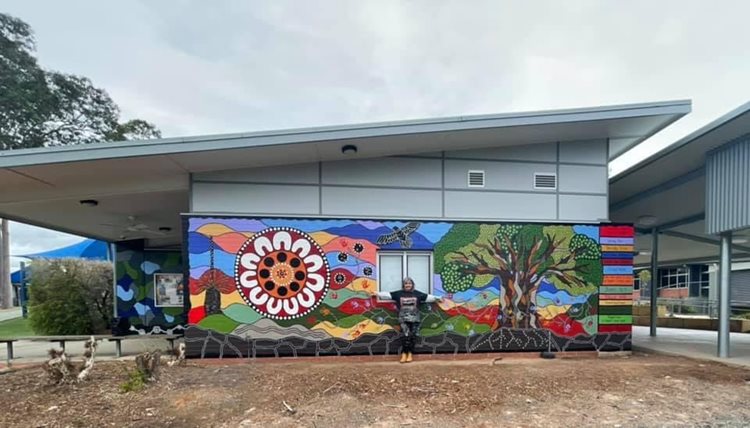I recently yarned with contemporary Queensland artist Wendy Rix about how Indigenous art murals and incursions can enrich your learning environment.
A descendant of the Yuwaalaraay people, Wendy's family is from Goodooga, New South Wales. She has been visiting schools and early learning services to share her Aboriginal art with children for many years. Through her interactive workshops and the collective experience of creating murals, she shares cultural experiences and helps children learn about how Indigenous artwork tells a story.
Bringing Aboriginal artists into services to engage in this way has multiple benefits for children. It can help to overcome the stereotypes and cultural bias that many children are exposed to through media, family, community, and school, which can lead to limited understanding of Aboriginal culture. The experience offers an opportunity to challenge these stereotypes and to celebrate the rich diversity, history and connection to place that Aboriginal communities have.
By connecting with children through her art, Wendy can show participants a beautiful visual and contemporary expression of culture.
"[It allows] kids and teachers to realise we are all from different backgrounds, different colours and different life situations," says Wendy. "But that I/we are still all Aboriginal, which can help overcome negative stereotypes."
Yarning about family to create shared connections
Wendy begins her workshops by introducing herself to the children before showing them her family history (which has both Aboriginal and non-Aboriginal heritage). She then invites the children to share their story and family history with her. This yarning is a wonderful way to help all children to better understand the Aboriginal perspective of positioning oneself in a group by sharing family connections. It also opens a platform for the children to gain or build on their understanding of Aboriginal kinship and connection to place.
Involving children in the artistic process
There are many ways to involve children in the artistic process. However, the level of involvement depends on the project. For example, some schools ask for classroom workshops where each child ends up with their own piece of art. If the session is related to NAIDOC week, they discuss that year's theme together and explore what the theme means for them in practical terms.
However, if the project is a mural, Wendy tells me that she is usually provided with a brief, which often focuses on broad values or themes. While the children are not generally involved a great deal in mural creation, Wendy has at times engaged children by adding to her art through their handprints or fingerprints.

The mural shown above is titled 'Gurumba bigi - Wunya-yaama', which means welcome/hello in both the Indigenous languages local to the school, and in Wendy's language. It represents the story of the building it's painted on, which houses the library, the defence room and First Nations room.
An opportunity to extend cultural appreciation and understanding
By engaging with an Aboriginal artist in their classroom, children can learn and grow their understanding of Aboriginal symbols and the diversity of Aboriginal art styles. They also find out about the role Aboriginal art plays in storytelling and knowledge-sharing in culture. All of this opens a platform for further interest and exploration of Aboriginal culture that the educator can build on at a later time.
It provides an opportunity to delve deeper into the local context of the lands on which your service is based. I have seen several beautiful examples where services or schools have engaged artists while also connecting with their local Elders. Together they have created pieces with their students that tell local Dreaming stories or share notable features of local culture, such as images of the local people's totems.
In a broader sense, having Aboriginal artists come into a service can help create a learning environment that champions cultural pride. This is important not only for the Aboriginal and Torres Strait Islander children at your service but also for non-Indigenous students.
Artwork can be a powerful medium, and when art such as this is created collaboratively and in the spirit of reconciliation, it can work to create a stronger sense of belonging within your service and community. So if you have a blank wall, path, or building in your service, why not consider engaging a local Aboriginal or Torres Strait Islander artist to come and create a special piece with your children? It is sure to be an enriching experience for all involved and will serve as a daily reminder to all who see it of the reconciliation journey your service is on.
Images courtesy of artist Wendy Rix of Wensart
Further learning and resources:
CARCLEW arts centre shares information about their Aboriginal Artists in Schools project: Teaching through Creation Stories
Search for Indigenous artists via Indigenous business directory Supply Nation
Amplify: How to conduct a bookshelf audit by Deborah Hoger
Amplify: Avoiding the trap of cultural tokenism by Deborah Hoger
CELA professional development relating to this topic
About Deborah
Deborah Hoger is a Dunghutti woman and owner and Director of a business specialising in Indigenous educational resources. She is passionate about using early childhood as a platform to introduce children to the rich depth of knowledge and unique perspectives that Indigenous Australia has to offer.